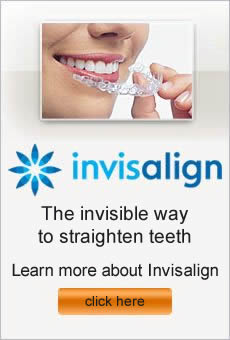You’ve probably heard of the modern approach to teeth straightening that requires wearing clear aligners to shift your teeth into better position. This nearly invisible method is appealing to people of all ages, but it is especially tempting to teenagers.
Unlike traditional braces, Invisalign’s clear aligners can be removed from your mouth for easy dental care. Simply remove the aligners, and brush and floss your teeth as you normally would. The aligners also may be removed for special occasions like school pictures, prom, or graduation. The ability to control when you’re wearing the aligners is especially appealing to teens. However, remember that for the fastest results, the clear braces should be worn for about 22 hours daily.
These clear braces have no restrictions on eating foods like popcorn or pizza or candy, since there are no concerns about breaking a wire or bracket. Also, teens find that Invisalign aligners are comfortable and durable. Typically, they don’t get in the way of extracurricular activities like playing an instrument or sport.
Invisalign Teen offers a wear indicator designed specifically for teenagers. Each aligner has a small blue indicator on it. When it’s time to move on to the next set of aligners in the treatment plan, the color changes and your teen knows to switch aligners. Adhering to the schedule for changing aligners is crucial to the success of treatment, so this provides great reassurance that your teen is sticking to the program.
Invisalign Teen is made to compensate for your teen’s growth of new teeth or molars. This includes wisdom teeth, which affects many teenagers. Plus, up to six free replacement aligners are included with Invisalign Teen for lost or broken aligners. It’s important to parents and teens alike to know that there is a backup for broken or lost aligners.
Only your orthodontist can determine if Invisalign Teen is right for your child, but it’s one option that you may want to investigate to achieve a beautiful smile while keeping your teen happy.
One of the tools orthodontists may use to help you achieve a perfect smile is called a palatal expander, which is an appliance that gently widens the upper jaw so that it fits properly with the lower jaw. The goal is to expand the jaw to avoid overcrowding of the teeth. Not every patient needs an expander, but if you do here are some common questions answered.
Who needs an expander?
Your orthodontist will evaluate if your jaw needs to be widened in order to get the results you desire. Expanders work best for people under age 15, because the jaw bones are still pliable and the roof of the mouth has not completely finished growing.
How does it work?
The palatal expander is made up of a screw attached to your upper teeth by bands secured around your molars. It is activated by turning the screw with a key. You will do this yourself after specific instructions from your orthodontist. The expander remains attached in your mouth until your doctor indicates it’s time to remove it.
Does it hurt?
As with many treatments for your mouth, it will take a few days to get used to the palatal expander. There may be some lisping at first, but your speech will return to normal as you get used to the device. You might feel slight pressure when the expander is activated with the key. Pain is rarely experienced, but over-the-counter pain medication usually relieves the discomfort.
How long do I have to wear the expander?
Treatment length varies among patients, but often expanders remain in place for 3-6 months. It is vital to follow your orthodontist’s instructions for activating the expander, in order to achieve the desired results within the anticipated timeframe. You will have periodic visits to your doctor to make sure the appliance is in the right place and is tight enough.
Your braces have been removed and your teeth are perfectly straight! It’s time to just enjoy your new smile since treatment is complete, right? Wrong! It’s time to wear your retainer so that your teeth stay in their new positions. A retainer is a custom-made appliance that continues to train your teeth to remain in place after your braces have been removed.
There are three types of retainers that orthodontists use to secure your new smile:
• Hawley: The most popular style, this is the traditional metal wire attached to an acrylic piece that fits in the roof of your mouth. You can take it in and out as desired.
• Essix: This type of retainer looks similar to Invisalign braces or to whitening trays. These are less noticeable than the traditional type, but are also flimsier and more breakable.
• Bonded: This permanent retainer consists of a wire being glued to the back of your teeth, and it cannot be removed by the patient. Your orthodontist will decide how long it remains in place; some remove the retainer dependent upon wisdom teeth removal, and others keep the retainer in place forever. One downside to this retainer is that tartar is difficult for dentists to remove with the retainer in place, so it’s very important to brush and floss properly and to see your dentist regularly.
Your orthodontist will help you decide which retainer is best for you. No matter what kind it is, the key is to wear it regularly for the recommended timeframe. Initially, that will be all day long for a number of months. Later, you’ll be able to only wear it at night. Remember, if you stop wearing your retainer, your teeth will shift. It may be the last step of your orthodontic treatment, but it’s also one of the most important.
Whether participating or cheering from the sidelines, Americans love sports. From baseball to football to basketball, we enjoy the thrill of competition. Participating in sports for recreation is great for your health, but it can be hazardous to your mouth. In fact, 40 percent of all sports injuries involve the face.
To keep your smile in tact, most dentists and orthodontists recommend wearing a mouth guard in contact sports like hockey, football, or soccer. As well, they also suggest using this type of dental appliance in non-contact activities such as skateboarding and bicycling. Mouth guards help cushion your teeth, gums, and jaws from common injuries sustained during sports activities.
Designed to cover your teeth, mouth guards come in different varieties, including:
• Ready-made
The least expensive option, ready-made mouth guards are also less comfortable and less effective than the other types of protection. You can find ready-made mouth guards at most sporting goods stores.
• Mouth-formed
Generally created from acrylic or thermoplastic materials, mouth-formed guards will shape to fit your mouth are being placed in boiling water. These mouth guards don’t offer the same level of support as custom-made appliances.
• Custom
This is the best option, as custom mouth guards are constructed to precisely fit your mouth. Your orthodontist will take a mold of your teeth that a dental lab will use to produce your custom mouth guard.
Once you purchase a mouth guard, make sure to take good care of your oral appliance. Clean and rinse the guard after each use; then, allow it to air dry. Remember to check the appliance before you play to ensure it is still in good condition.
Mouthguards at Mehdi Fotovat Sherman Oaks, CA Orthodontist
Though babies and toddlers use thumb-sucking to self-sooth, this habit can cause dental problems if your child continues as he or she grows up. By age six, you should work on curbing this habit so that you don’t end up with correct teeth, bite concerns, or additional treatment costs. Talk with your dentist or orthodontist for specific recommendations about handling the issue.
The following suggestions may help you work with your child to stop the thumb-sucking:
• Use positive affirmations. Instead of scolding your child for thumb-sucking, offer praise when he or she isn’t engaged in the behavior.
• Dig deeper. Often, children suck their thumbs because of fear or anxiety.
• Identifying the cause of the concerns may reduce your child’s need for this type of comfort.
• Create a plan. Talk with your child and get his or her input for the best way to stop the thumb-sucking. When you involve your child in the process, you may see more willing participation.
• Call in reinforcements. Ask your dentist and/or orthodontist to speak with your child and explain the oral health consequences for thumb-sucking.
• Add a deterrent. Sometimes, placing a sock over the thumb, wrapping a bandage around the digit, or using a thumb guard will make it difficult for your child to keep up the habit.
• Offer incentives. Let your child come up with a special reward for kicking the thumb-sucking habit. A new video game, coveted toy, or special dinner may provide the necessary push your child needs.
Straight teeth at Mehdi Fotovat Sherman Oaks Orthodontist



